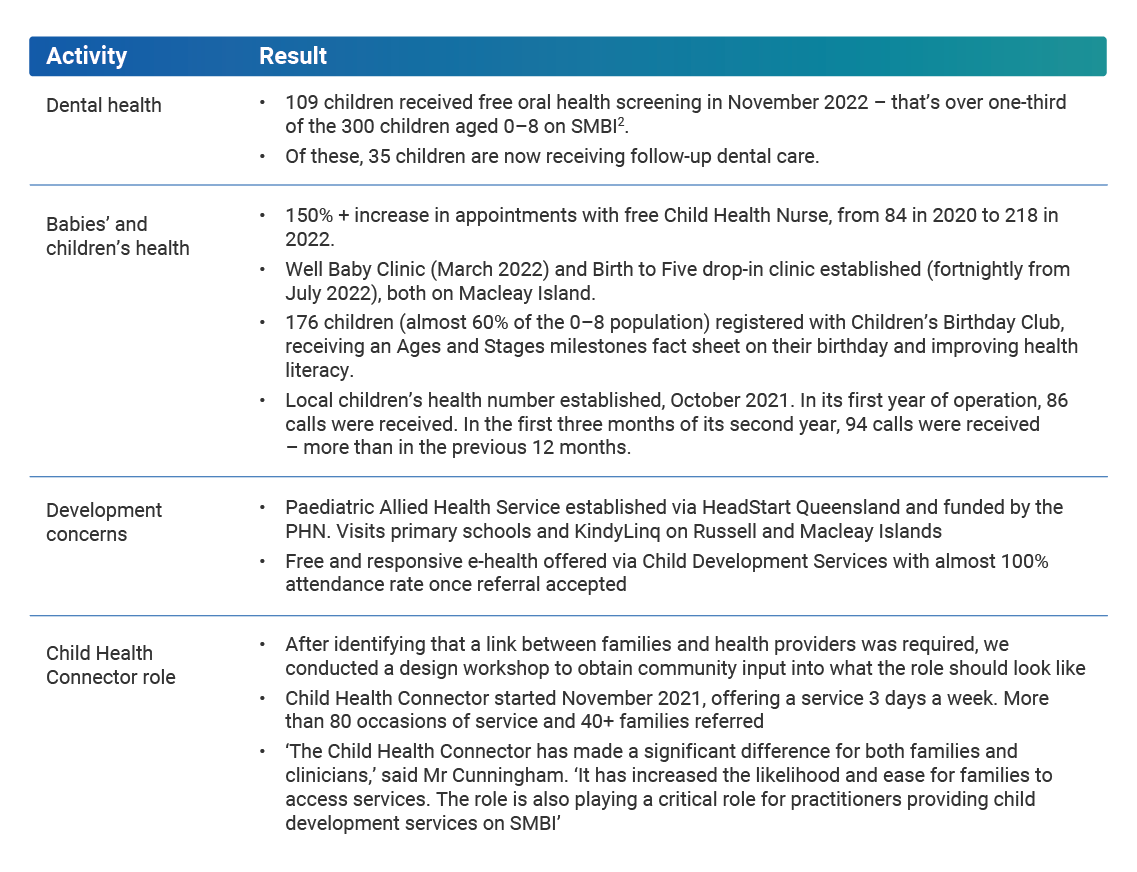Locals leading the way: The SMBI story of community-driven health transformation
Key points:
- The Southern Moreton Bay Islands are comprised of Karragarra, Lamb, Macleay, and Russell Islands.
- Isolation from the mainland leads to social and health inequities. Rates of unemployment, socio-economic disadvantage, and child development issues are high.
- Brisbane South PHN has been working with SMBI Listeners Inc. and other key partners for five years.
- We’ve primarily focused on improving the health and wellbeing of children aged 0–8 and building relationships and trust with the community.
- This effort has led to increased engagement with health services, a collaborative culture, and a shared learning environment.
Gone are the days where a one-size-fits-all medical approach was the accepted norm for public health services.
Today, mainstream concepts of health are being viewed through a wider lens, acknowledging the intricate patterns formed by societal, structural, and institutional disparities experienced by people and communities across the globe.
Here, in Australia, the shift towards a more nuanced public health model is palpable. More and more, governments and health system partners are coming to accept that programmatic solutions are not the sole answer to closing population gaps in health and wellbeing outcomes. It calls for the peeling back of layers of top-down bureaucracy to discuss, plan and co-design health care initiatives with community there at the table; it requires listening and learning from the very people the system aims to serve.
Enter: Primary Health Networks (PHNs), uniquely positioned as regionalised, independent health care commissioning entities established across the country. Their mandate? To champion preventative care and partner for person-centred, community-led healthcare strategies that resonate at a grassroots level, helping to improve health outcomes for vulnerable communities.
A case in point is the vibrant community initiative unfolding on the Southern Moreton Bay Islands (SMBI), championed by Brisbane South PHN and key health system partners. Here, a new narrative is being written, one that prioritises the health and wellbeing of its residents, particularly the children and families, through innovative, community-led interventions.
A closer look at the Southern Moreton Bay Islands
The Southern Moreton Bay Islands (SMBI) are a group of four islands – Karragarra, Lamb, Macleay, and Russell – located near the south-west point of North Stradbroke Island and 20 minutes by ferry from Redland Bay. The islands are home to around 750 families and 10,000 people.
The lifestyle is peaceful and relaxed, but the community’s separation from the mainland also brings its greatest challenge – inadequate access to health and social services.
The only way on or off the islands is by ferry, barge or dinghy, and residents need to have a car on the mainland or rely on public transport once they get there. This means a trip to seek health services on the mainland can take a whole day. Some residents report sleeping in their cars if they can’t get home after an appointment.
Many of the children and families living on the islands are vulnerable, with access issues compounded by significant societal disadvantages. Further, child development issues and the rates of domestic and family violence are some of the highest in South East Queensland.
Resident Profile for Southern Moreton Bay Islands Statistical Area Level 2
| SMBI population | Queensland population | |
|---|---|---|
| Socio-economic quintile | 94.1% in most disadvantaged quintile | 20% in most disadvantaged quintile |
| Unemployed | 9.3% | 3.8% |
| Median total income | $455 per week | $787 per week |
Source: Queensland Government Statistician’s Office, Queensland Treasury, Queensland Regional Profiles: Resident Profile for Southern Moreton Bay Islands Statistical Area Level 2, 11 September 2023.
Social and health funding: what hasn’t worked
In the past, social and health funding focused on the broader geographic catchment area of Redland Bay.
Mainland models of care didn’t appear to always understand or cater to the unique cultural needs of the SMBI community, with funding support for the islands traditionally seen as an ‘uncosted add-on’.
As a result, the community reported they rarely felt consulted, did not feel heard and never felt part of the solutions offered.
The SMBI Community Impact Initiative
While the SMBI community has numerous skills, strengths, and lived experiences, many reported they were unable to access the healthcare and social services they needed. Government data and community conversations indicated that challenges were entrenched beyond the scope of any individual program to effectively address.
A new approach was required to understand what it might take to provide accessible, culturally informed and inclusive services and programs to children and families in the community.
In response, the PHN opted to strategically lead a different, innovative way of working. With a foundation in international research and evidence, we began tackling historically poor health and wellbeing outcomes of SMBI children and families by applying an adaptive learning approach, with community voices leading the way.
We have been working in partnership with SMBI Listeners Inc. and other key partners for five years. Together, all have contributed to developing the SMBI Community Impact Initiative. The objective is to improve the health and wellbeing of SMBI children from birth to 8 years old, as well as their families, while by bringing to life a place-based community-led approach.
We have 4 focus areas, as agreed in 2020 by the SMBI Community Governance Group:
- healthy, thriving children
- healthy family relationships
- strong and connected community
- wellbeing and recreational activities for school-aged children.
What’s different about this approach?
The SMBI Community Impact Initiative is designed to support and grow a sustainable, adaptive learning ecology, via a community-driven, cross-sector, place-based approach.
We are community-led
‘The approach is fundamentally collaborative. We respect and value community leadership and input through SMBI Listeners Inc.,’ said Craig Cunningham, Brisbane South PHN’s Senior Program Development Coordinator – Child and Youth.
SMBI Listeners Inc.1 was established to develop community agency, bring a nuanced perspective, and help enable community voices and insights to be known when making decisions about them. It serves as a conduit between the community, healthcare and education system partners.
‘Whenever possible, we must ensure community voices are at the table when making decisions that affect them,’ said Mr Cunningham.
Since 2018, SMBI Listeners Inc., service providers and stakeholders have had around 4,000 conversations with community members. SMBI Listeners Inc. has a level of legitimacy and trust within their community that enables them to listen to, quickly connect with, and further support residents’ needs. These conversations ensure the community has a voice – not just in response to the funding of services, but in how health care is designed, delivered, and experienced by children and families.
The SMBI way of working is also wishing to amplify and explicitly acknowledge the role families, carers and numerous community members play in improving the health and wellbeing of children and families. It's not all about services - the community led bubs and family groups are but one example of this. Community supporting community! In short, ‘nothing about us without us’.
We partner across sectors
It’s widely recognised that health outcomes are influenced by many factors beyond the traditional scope of health service models. Adopting a cross-sector community led approach has enabled community and services to work better together, including integrating the service experience when appropriate. Strengthening relationships and trust between the community and between service providers has led to positive results. These include:
-
Services and the service experience is being co-designed and co-produced, such as a hybrid-designed child development service and e-health experience.
-
The community leaders involved are confident and have strong, respectful relationships with service providers. This is making it easier to identify problems and design and test solutions together.
-
Service delivery partners have a better understanding of the unique challenges and problems that matter to the community and that can drive change.
-
The community is engaged and mobilising. For example, as active members of the Community Governance Group and the SMBI Innovation Lab.
Our solutions are place-based
SMBI Listeners Inc. intimately understands their own community and arguably how best to engage and mobilise residents. This has been instrumental in developing trust and understanding between system partners and the community.
‘I’d suggest the SMBI approach is different to other place-based work around Australia’, said Mr Cunningham. ‘We are collectively taking responsibility for creating and protecting safe learning environments – so together, we’re growing a sustainable learning ecology, where we use collective intelligence to experiment - to try, test and learn what works for SMBI. We are generating context specific, practice-based evidence.
A service provider might have exceptional clinical expertise, but they can’t do good work if the community doesn’t know about or trust them. There may be critical interdependencies sitting beyond the control of an individual service. Those interdependencies need to be known and actors need to have line of sight of these. Often we need to play well together to get the job done. A healthy learning ecology is like a fine orchestra - we all have a role to play.
Amy Fernando, Manager of SMBI Listeners Inc., agrees that trust is paramount to the initiative’s success. ‘A lot of parents haven’t had a great experience with schools or health services in their past , so it’s very difficult for them to cross the threshold of a school, doctor or government building. Sometimes, at first we literally need to hold someone’s hand to take them through the door. Building trust with the community goes a long way towards eliminating that fear.’
What are the collective achievements so far?
‘In the past, SMBI residents felt services would come and go, but this initiative is different, as community and service providers are working together, we've learnt we need to consider more than service delivery. We’re valuing and enabling learning, we are acknowledging practitioners' expertise and leveraging the community’s knowledge, capacity and assets. Healthy relationships enable understanding, trust and confidence to grow. So, continually cultivating these conditions is proving critical,’ said Mr Cunningham.
Here’s a snapshot of some of the measurable results we’ve achieved in the past couple of years:

Where to from here?
We have 3 areas of focus over the next 2 years:
We will fine-tune our partnership with SMBI Listeners Inc., with the PHN acting as a system lead and SMBI Listeners Inc. as a critical context and community expert.
Secondly, to consolidate implementation and our learning approach. We wish to better understand how we might sustainably weave a practice of learning to access in real time and at completion—about how, where, for whom, and over what time frame, which aspects of an intervention may (or may not) have succeeded, and thus where improvements might be sought.
Thirdly, we see SMBI as an opportunity for leading and contributing to place-based learning nationally, via a partnership with Griffith Centre for Systems Innovation. This partnership allows us to collectively explore, test and learn more about how governance and investment structures (and functions) could be strengthened, better understood and where necessary, reimagined, so place-based initiatives like that on SMBI could deliver better outcomes in and with communities.
The Centre is also supporting growing the capability of community and service delivery partners to sustain a practice that drives innovation.
More broadly, the initiative embodies a shift towards empowering communities to lead in shaping their health outcomes. It's a forward-thinking model with global relevance, showcasing the efficacy of place-based investments in creating sustainable health improvements. As we refine our approach, the SMBI experience will contribute to a blueprint for community-driven health innovation, demonstrating that when local communities can lead, meaningful change follows.
More information and resources
- To speak with us about the initiative or learn more about opportunities to collaborate, please contact Craig Cunningham at ccunningham@bsphn.org.au
- Read our South Morten Bay Islands Report (2022)
Editor's note: This article was first published in issue 7 of our Primary Health Impact magazine.





